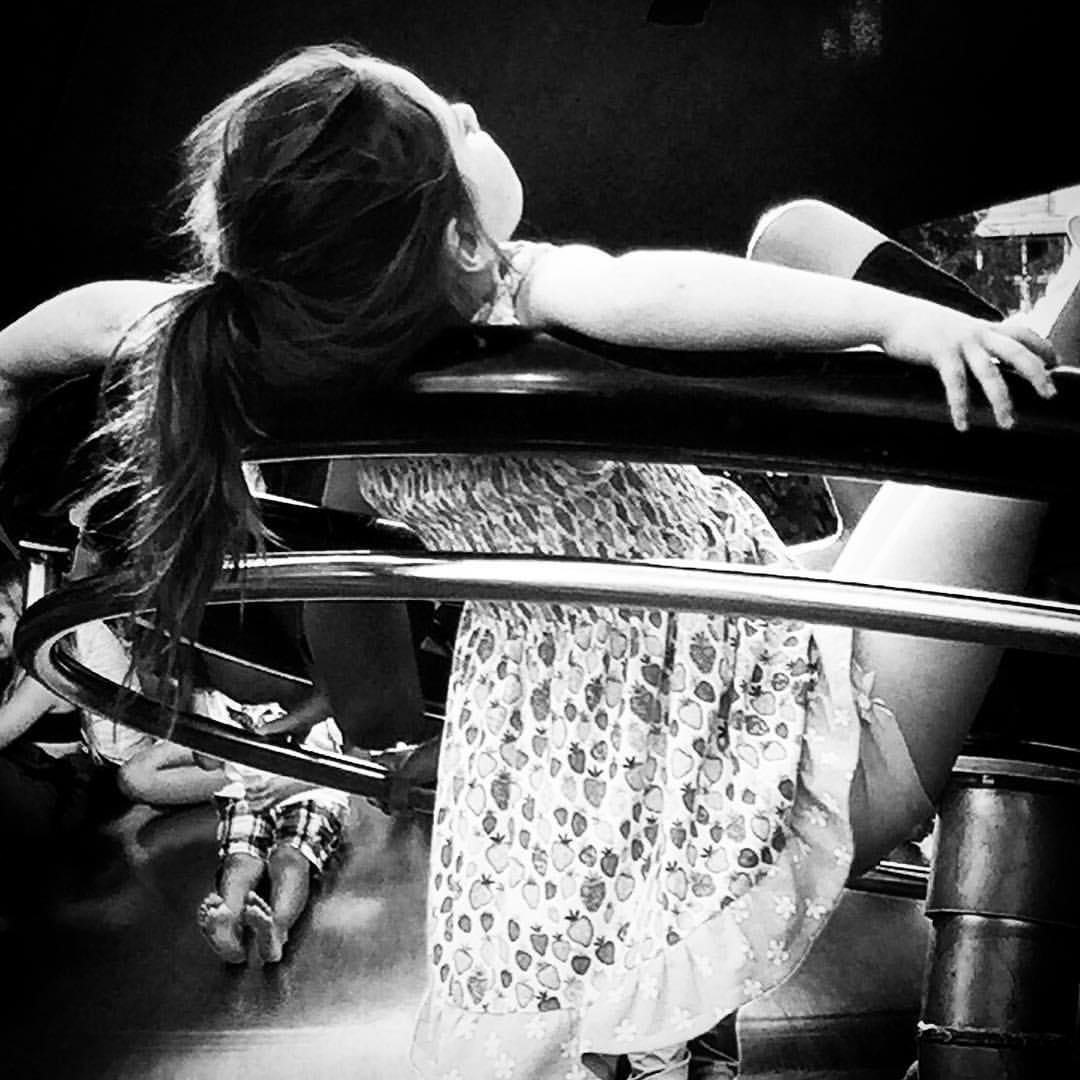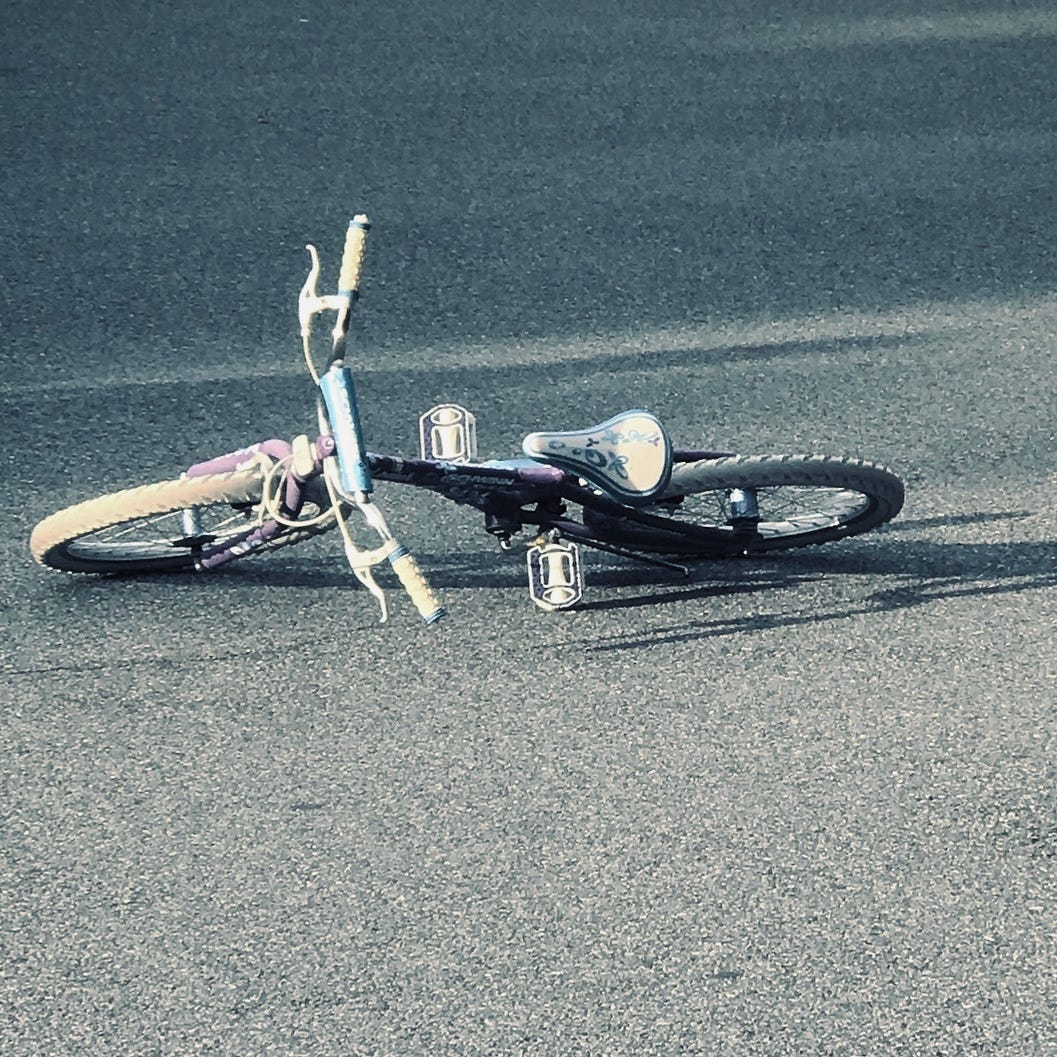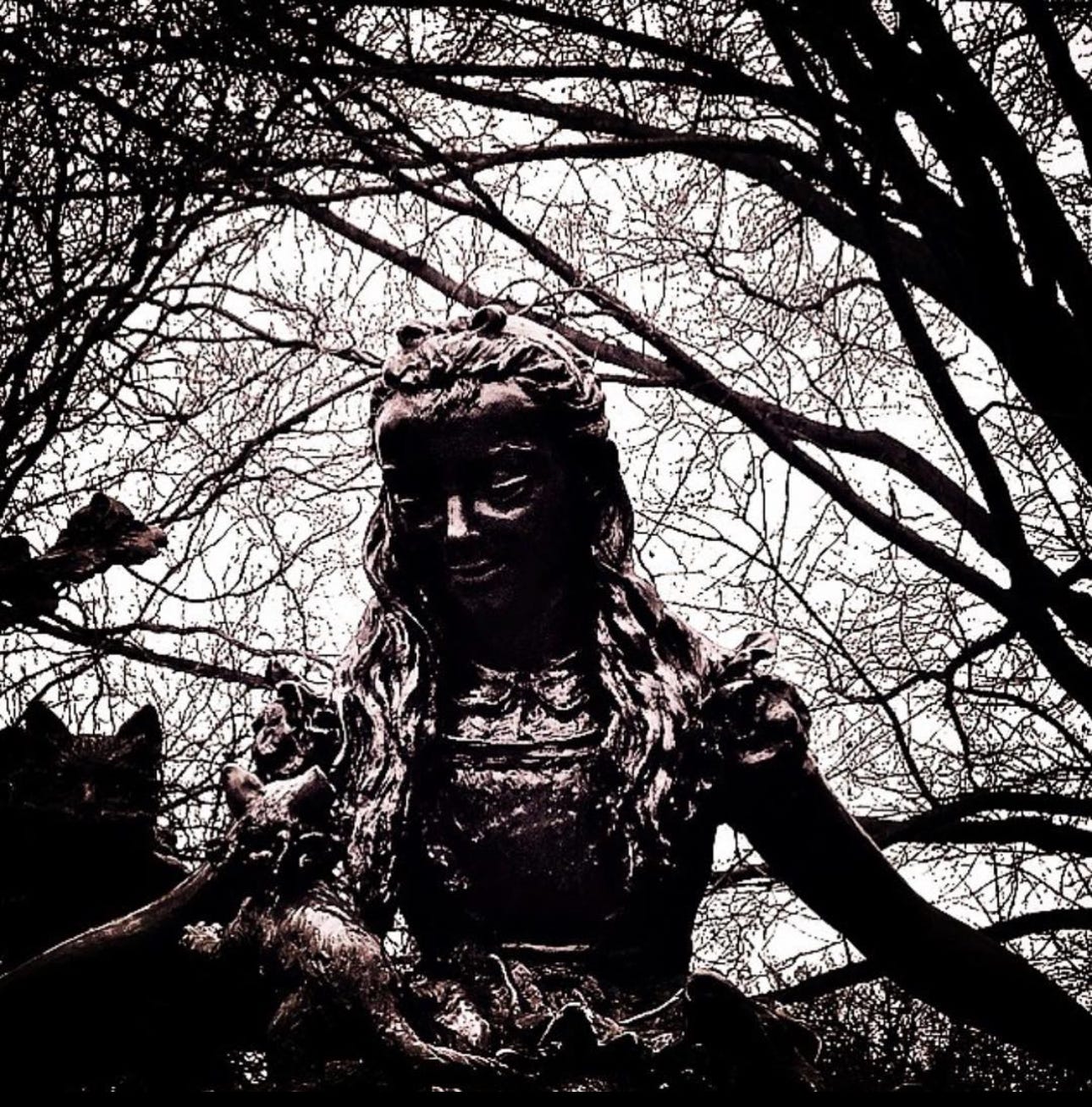And her face brightened up at the thought that she was now the right size for going through the little door into that lovely garden. First, however, she waited for a few minutes to see if she was going to shrink any further: she felt a little nervous about this; ‘for it might end, you know,’ said Alice to herself, ‘in my going out altogether, like a candle. I wonder what I should be like then?’ And she tried to fancy what the flame of a candle is like after the candle is blown out, for she could not remember ever having seen such a thing.
— Lewis Carroll, Alice In Wonderland.
It’s 2005.
They lose your results and then find them. When the black film is finally pulled from its manilla envelope and pushed against the light screen on the wall you can see it. A rogue fleck of white where all else is shadow. The whiteness is a disc, flushed out of proper alignment with your spine, digging straight into the sciatic nerve, which extends all the way down your leg. Severely herniated. This explains the numbness and tingling, the wrapping burn of muscle pain. You are diagnosed. You are identified.
“What you have causes the worst kind of back pain. It’s amazing you’re even up and around,” a pallid and exhausted-looking young doctor says as you fight your own anatomy to sit up under the low hum of yellow fluorescents.
“I mean I have back problems,” he says. “But not like this.”
He points back to the shadowy screen.
You feel satisfied, even a little bit impressed with yourself. Everyone can see it now. Your pain is BAD.
To make sure, you get a second opinion and are told the same thing. Yes, it’s clear, right there on the film. Your situation is very bad.
They found it. And now, a few weeks before the surgery, you are given a prescription for Percocet. A fat orange bottle of 60 chalky round pills. Five milligrams each. One to be taken every four to six hours as needed.
You feel an intense, pervasive itchiness at first. You claw at your own skin to relieve it. Soon, though. The pain. The pain you’ve been collapsing the rest of your body around for weeks, months, years?
A long time.
The pills help the pain.
It’s 2001. Thanksgiving. Your friend M. picks you up in his light blue Honda to go volunteer at the needle exchange down by the Bowery. You move hot foods other people have cooked out of their tupperware into deep metal dishes. Brown-skinned turkey and different versions of stuffing and marshmallow-topped sweet potatoes and oily Brussels sprouts and syrupy cranberries. Small pilot lights burn below to keep everything warm.
You will serve dinner on the Lower East Side for a few hours. You will see how the gauntness of flesh pulled tight around bone makes a person’s eyes look wide and childlike, no matter how old they are. You will learn to actually feel the texture of gratitude. A warm space with no judgment. A smile with no expectation that any broken thing be fixed. An edgeless light of kindness.
You’ve just ended a long relationship with someone you thought about marrying and having babies with, so you feel the pitch of early darkness and the glass-sharp ledge of a late November chill. The low thrumming panic of heartbreak, the end of something. The place of not-aloneness you built with him that felt safe even when it was very bad. It felt like an answer to emptiness even when he was inexplicably vicious. You learn endings are no less brutal when you choose them. For a couple of hours here with your friend, placing nourishment in the space where hunger craves it, a thought stutters around your head like a trapped moth. You will not know if it was a memory or a premonition.
There but for the grace of God go I.
It’s 1994. You are in your mother’s big blue bed, watching O.J. Simpson’s Bronco slowly lead a series of police cars down a Los Angeles freeway. People gather on bridges with signs. They’ve bought oaktag and used colored markers. They wave hand-scrawled messages of love and support in the direction of their hero beneath the droning flapflapflap of helicopters.
It’s summer, and the days are waving their lush tree arms at you through dusty gold light that will last long past evening, slanting through the corners of cracked windows.
You are taking oblong yellow sticks of Vicodin for the four empty spaces where your wisdom teeth were growing in all wrong. Impossible right angles, the dentist said.
O.J. Simpson is crouched in the backseat of a big white car rolling slowly down a California interstate with a gun to his head. America watches. You sink back from the electric mayhem of it all. Your country folds in on itself through a TV screen, split between basketball and bloodshed. You feel buttery with indifference.
A dream within a dream.
It’s somewhere between 2006 and 2008.
You spill a bottle out of your overstuffed bag on the Upper West Side and get down on your hands and knees to pick up every last tiny pill off of the filthy city sidewalk. You do this in front of passing strangers and members of your extended family, visiting from out of town.
In a small self-effacing voice, you make a joke about being a junkie. Everyone laughs. Because, really, it’s just extremely good news that you can leave the house today. It’s good news you can sit upright at a table with people who care about you, to eat lunch before too much time passes, before you start to sweat and twist in your seat. Before you have to take another pill to make those feelings stop. To still the rattled thumping of your panicked heart, to cut the skin-crawling agitation, to quell the nauseous imperial body ache.
But hahahaha I mean come on,
this is you,
and you are not really an addict.
—
It’s 1979. You are about to have your tonsils and adenoids removed because you get sick too often, raw sore throats that feel like swallowing invisible razor blades, and ear infections so severe your teachers say you seem to go a little bit deaf.
You are seven.
Before tonsil and adenoid surgery in 1979, children were prepared by way of broadly sketched picture books and film strips that ding when it’s time to move the mechanical wheel.
But there are some things they do not tell you about the hospital and being very sick. That for many nights afterward, you will get to sleep with your mom in her soft blue bed. That you will get to eat scrambled eggs and raspberry Jell-O for Thanksgiving dinner. That your dad will come in his pressed gray suit and striped purple tie from work, and he will stand still and steady nearby. That his big hand on your cold head will be warm when you throw up after the surgery. That he will give you a huge stuffed moose you will name Romeo the Moose after Dr. Romeo, the tall, kind, slow-voiced anesthesiologist. That there will be vast amounts of chocolate ice cream.
Also.
No one will tell you what it feels like soon after the needle lobs through your skin like a single wasp sting. That if you are brave enough for this pain, on the other side of the very good vein, something will seep through your blood, and you will feel lifted from your body. Gently. A little bit far away, but not far enough to make you afraid. The exact distance where you are not all tied up with your blood and bones and drumming heart and tallest girl in the class, too tall for the boys to have crushes on you, and oh my you are taller than they are aren’t you. You are no longer bound to chest-gripping anxiety. No longer webbed inside the net of spiking cortisol, which no one will explain is not a normal way to feel for at least another 25 years. The deep-down part, no one knows because you’re a seemingly joyful, athletic, entertaining, motivated, mature little girl. And it’s not that this part of you isn’t real. It’s not that she isn’t you.
It’s just that you have another life. Mostly at night, before you can sleep, when you are a spell-casting radio sponge. The part that hums at the lowest edges of you, so persistent and automatic, you will not recognize it as a ticking metronome for a long, long, long time. The part of you that is constantly tuning. Tuning in to all the grownup faces, tuning to the Universe behind their eyes, so you can figure out what’s coming next because you must have missed it the first time. Who will stay and who will go, who is happy and who is sad, and if you read this right, if you do this perfectly, you think you can control it. If you gauge all the feelings behind the faces and make them brighten in response to yours, you will hold everyone together. You will not be alone.
But sometimes, you don’t understand the frequency of the static rushing in. Sometimes, a station is someone else’s anger or sadness, or yearning, and in some unassuageable way, you believe the sadness, the yearning, the unspoken anger of the people you love is what you were brought here to fix.
It’s 2016. Prince is found dead in an elevator with no obvious signs of trauma.
No one can believe this, and everyone grieves.
Something about hip pain and grounding a private plane for the flu a few days before.
It’s 2014. Philip Seymour Hoffman is found dead on his bathroom floor.
Something about a lifelong struggle, and then the pills. A lot of demons lately.
No one can believe this, and everyone grieves.
It’s 2008. Heath Ledger is found dead by a housekeeper.
Something about being only 28. A hard time sleeping lately. A beautiful little girl.
No one can believe this, and everyone grieves.
Everyone loved him.
The bodies, alone.
It’s the end of 2007. On a break from your office job, where you frequently fall asleep sitting at your desk, you charge $300 bottles of generic hydrocodone from internet pharmacies to your nearly maxed-out credit cards. Your back surgeon’s prescription counts aren’t enough, and he says something to you about no more pills. Amanda, I don’t want you to become dependent on them and anyway, what you clearly need is more surgery because evidently the first one failed, and it seems the pain is becoming chronic. Then he fires you as his patient because you stop showing up for appointments. You stop showing up for appointments because you’re too tired to get out of bed.
As tired as you are, there will be a winter evening when you chase down a package you missed to a FedEx location near the low lights of the West Side Highway. You will get there just before it closes and sit in the near dark, sweating and aching, waiting for the last delivery because the pills are not working as well anymore, so you have to take them every three and a half hours instead of every four (to six), which means that by the end of the month, you’ll be short.
Your psychopharmacologist, who is supposed to be treating you for anxiety and depression, refers you to a new pain management doctor. The new doctor says you have the single lowest pain threshold he’s ever measured on anyone — and he does indeed measure it on you with the pulsing electrical machine he says he invented. He runs it all over your body, pausing on top of various muscle clusters to let it whir and sizzle in response to your wincing contractions. His office has figurine buddhas and paintings of pastel waterfalls everywhere, so clearly, he cares not just about your pain but about your spirit.
He says you’re not taking enough medication; otherwise, why would you be in so much pain? You have many large manila folders containing evidence to support this theory. MRIs and X-rays, doctors’ notes, and surgeons’ records. You have a history dating back to when you were 18 years old, just after you graduated from high school, when all of everything was ahead of you. When you leaned over to pick a T-shirt up off the floor and felt the first blistery twinge of your body’s betrayal.
You believe this new doctor and the other doctors that follow who say it’s fine to keep taking 140 milligrams of Oxycodone and OxyContin, which is what you’re now taking every day because it turns out there’s too much Tylenol in Vicodin and Percocet and too much Tylenol is bad for your liver and you are a legitimate pain patient you are not an addict and besides, nothing else has worked. Not the excruciating ‘muscle softening’ injections, conducted with a crochet-sized needle, which leave you covered in yellow and blue bruises for weeks. Not the tiny, delicate acupuncture needles that leave you weeping on a table because of how crossed your pain signals have become in response to the slightest stimuli. Not the assigned PT exercises with the very clear diagrams that look like disjointed crime scene bodies, you initially got from a doctor who said you simply needed to strengthen your core. You believe the doctors who say that only the pills seem to really help you.
But the pain is not going away. In fact, it is getting worse, years now after the original injury and the surgery that was supposed to correct it. It is only being managed in the sense that every three hours or so (closer to three than three and a half), you take another pill and have some brief, faraway feeling of muted relief.
You will continue to grasp at this feeling like it’s your last penny dropped in a cloudy lake.
And eventually, you will wonder:
Is the feeling you tried to get back four to six times every day and night from 2005 until 2012 the actual feeling, or is it the memory of the feeling? Is it relief or the memory of relief?
Is it you, or is it the memory
of
you?
—
It’s 2016. A wide-shouldered dark-haired man in a flannel shirt starts telling everyone they need to buy a drug to help them take a normal shit because that’s how many American TV watchers are constipated due to opioids after back surgery. Handsome Wide-Shouldered Prime Time Flannel Man might as well be selling you Fruit Loops or a Lincoln Continental.
—
It’s 23 hours ago.
In a 100-page complaint, the state of New Hampshire files a lawsuit against Purdue Pharmaceuticals. Doctors will testify that drug reps visited them as often as two or three times a week, downplaying the addictive risks of OxyContin and other opioids being manufactured, particularly in the treatment of chronic pain.
Safe, safe, safe, is what the doctors will report, the company representatives said.
It’s tomorrow.
The President, under intense pressure from local governments and his own task force, will declare the opioid situation not just a crisis, not merely an epidemic, but a National Emergency.
But this already happened. And everyone knows.
The CDC has already told everyone that, from 2000 to 2014, nearly half a million Americans died from drug overdoses. More than six out of 10 deaths in 2014 involved opioids, including opioid pain relievers and heroin. The largest increase in opioid overdose deaths involved synthetic opioids. According to the CDC, “the most commonly prescribed opioid pain relievers, those classified as natural or semi-synthetic opioids such as oxycodone and hydrocodone, continue to be involved in more overdose deaths than any other opioid type.”
The LA Times will have already published a sweeping investigation detailing the mercenary nature of Purdue’s intentions to bury the truth about these drugs, particularly OxyContin, over a year earlier.
It’s 2008.
You rent a small green car and drive two hours from the tiny brittle town in Arizona, where you’ve been checked in since losing your office job and being struck lifeless by an episode of Major Depression. The windows are open, and the landscape suddenly shifts from flat and dusty, dotted with cacti, to soaring, majestic, and otherworldly. “Calling All Angels” comes on the radio, and you find yourself weeping to the point of blindness, but it doesn’t matter because the road ahead of you stretches on forever and is empty.
According to the head psychiatrist at the rehab center you are driving away from, these pills, while controversial, exist for people exactly like you. People who aren’t abusing them. People with real chronic pain. She tells you it would be better if you weren’t on them, and the facility would happily help get you off them, but if you choose not to put yourself through what would be involved in doing so, that’s okay too. You are doing the emotional work on yourself, and the medication doesn’t seem to be inhibiting you.
The head psychiatrist doesn’t need to know you have a small stash of extras hidden in your night-table drawer. You had them mailed from your pharmacy in New York. You take them when what the counselors back at rehab dish out at medication time isn’t sufficient for the pain.
High up in the Mars-like red rocks of Sedona, you will lie on a table while a lady shaman circles your body.
She will wave black spotted feathers, do incantations you don’t understand, and snap her fingers to some hidden beat. She will seem to move your muscles and bones without hurting them, and you will wonder,
Is this what it feels like to be touched by someone who wants nothing in return?
And then, as though she is a conduit for doctors in another dimension, she will press her warm hands up and down around your heart and say,
“I’ve never seen anything like this.
It’s like trying to revive a dead body.”
It’s June 30, 2012.
After eight months of sleepless nights and seizing muscle cramps, of uncontrollable sneezing and irreconcilable weeping, of exhaustion so leadening you wonder if anyone has ever died from it, you will reach the end of what is known as a ‘slow taper’ and take your last half of a five milligram Percocet.
You do this even though you are told by the psychopharmacologist, the one who recommended the pain management doctor, that it’s easy enough to wean a newborn off high doses of opiates, if necessary.
We do it all the time, he says with a shrug when you tell him you need to get off the drugs so you can try to have a baby.
In the midst of the tapering, you go back to see the pain management doctor, the one who said you were under-medicated. He smiles at you in front of a green figurine Buddha with what you still believe to be genuine curiosity and concern. He asks how you feel.
You tell him you don’t understand it. You are on about 75% less medication at this point, yet feel like you’re in about 75% less pain.
He nods and responds, seemingly without surprise, “That means you probably had opioid hyperalgesia.”
“What’s that?” you will ask.
“That’s when the medication reverses its palliative effect and actually causes more and increasing pain.”
This doctor has been writing you prescriptions for five years. He looks you in the eye when he speaks.
Oh
is what you say back to him.
It’s a year before he dies. Maybe two. You swipe a bottle of Percocet off your dad’s dining room table after some procedure he’s had to make sure you’ll be covered at the end of the month. He says he doesn’t like to take pills. They make him too woozy. This is what you will tell yourself over and over for years after he’s gone, when you feel sick with the shame of stealing drugs from your own father.
youarenotanaddictyouarenotanaddictyouarenotanaddict
You.
Are.
Not.
An
Addict.
It’s 1977. You are five years old and spend the entire summer attempting to fly. This does not involve much more than jumping off diving boards and low tree branches and white paint-peeled lifeguard chairs dug into soft sand, making a wish, saying a prayer as you go. One day, it’s simply you jumping a few inches off your father’s gray deck into the tickling green grass beneath it, holding a bunch of yellow balloons. Over and over.
You do not fly. You fall. You get splinters from trying.
But still.
The faith.
Remember that summer. The heat. The way your body moved without restriction. The way you turned cartwheels as easily as walking. The way you made the needle-thin spokes of your tricycle wheels turn from only the pressure of your sandal-less feet.
The faith. That if you only found the right method, tried just hard enough, you might escape the defining force of this particular planet. The relentless pull into the center of our broken-bodied Earth. Inescapable home. Spinning at impossible angles and speeds. Running on nightmares and grace.
You will remember spending these hot, long, lonely days trying to get back inside the crook of your mother’s sweet-smelling neck and soft, golden arms, back further than that to wherever you came from before belonging to her—or to anyone.
And you will resist this drive until you don’t. You will chase the deep ache of your own beating heart until you won’t.
It’s every day afterward.
You return your self from the exodus.
You scrape yourself down to the bone.
Your body grows back its own nerve endings.
You mark time beyond swallowing a pill.
You do exercises to strengthen your core.
Pain causes fear, and fear is contraction, and contraction collapses you into a fist, a ball.
Collapsing around what hurts doesn’t work.
You must teach yourself to take up space and relearn how to be tall.
Gardens are buried everywhere.
Shame will keep you its prisoner if you let it. It will whisper to you in the dark.
Never tell them about any of this. No one has to know who you are.
Answer the darkness with a flight into your longest shadows. Sleep beside them until they depart. They will go when they’ve been recognized.
There is always a window, a door.
Forgive yourself.
For every tiny terrible thing.
And then, from the ledge of a late summer day, by the light of a candle you lit for yourself, through the flickery flame of your own survival,
Tell this.












This. All of this.
June 16 was a year off of benzos for me. And here I am, a year off the medication I took for my overwhelming anxiety and insomnia…not anxious. Sleeping better; in fact, sleeping well. No one ever told me about “reverse tolerance” or any of these possible side effects during the 24 years that medical professionals were prescribing them for me.
This is a beautiful piece, Amanda. Thank you for sharing it and a million mazels.
WOW!! An incredible piece, so well written and riveting. I am so proud of you and congratulate you on your 12 years of abstinence and your ability to reflect in a way to help others struggling with the demons which overwhelmed you for much too long. Keep writing...you are gifted and need to be heard. Never forget where you were and what you have accomplished. You are a special soul with a special gift. And millions more mazels.